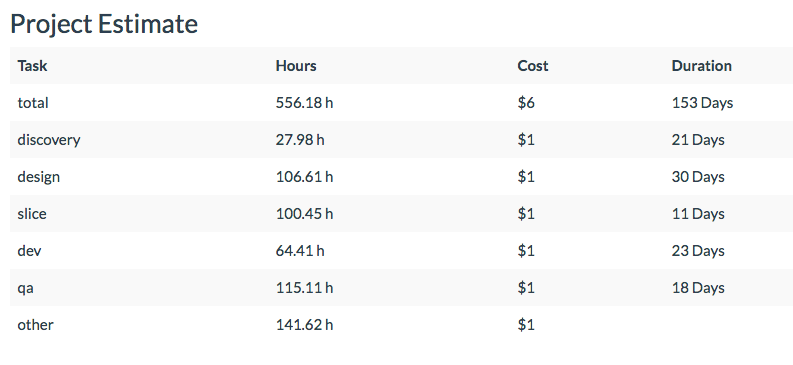For any estimate to be remotely accurate, it needs to be powered by both experience and data. At Engage, this is something we internalized a few years ago. This, combined with a dedication to providing the best service for our clients, was the impetus for creating our internally used estimate generation system.
When I’m talking about estimates, I’m talking about providing a cost and time estimate for our clients in order to produce their identified deliverables. While we provide multiple services at Engage, our tool (and this post) currently generates estimates for website, web application, and branding exercise projects.
Estimates, in general
For most, estimate generation is an art. I’ve sat on both sides of the table (client and agency) in several different settings over the past 10 years and have found that to be generally true. And there is nothing wrong with that. Folks use intuition to produce well-intentioned estimates. For many agencies, this is good enough. But to me, there was always a sense that something was lacking. Good enough was not good enough for us on this front. Thus, we’ve matured that art into an art/science hybrid that makes everyone’s jobs easier and more accurate when it comes to estimate generation and that leads to better managed expectations for our clients.
The issue with the art only approach is that:
- Intuition can be wrong
- Timelines are produced considering ideal situations.
Intuition is great. Experienced intuition is better. It gives you a better head start towards accurate projection in a way that its alternative couldn’t consistently provide. That said, it’s based on what one merely perceives about a project (which is not holistic in many cases) and it tends to be optimistic. Optimism (in estimates) anyway, is not usually a good thing. Especially when it comes to what’s involved or how long something takes. It might create an environment that leads to the contract being signed sooner, but it won’t lead to an optimal experience. It will ultimately cause issues down the road (frequently in the form of going over budgets and missed deadlines).
The same applies to timelines. I can tell you how long something will take, but that usually exists in a vacuum. There are other variables to consider: internal meetings, multiple clients, management responsibilities, lunch, etc. So our quest for building the perfect estimate generation tool was born from asking 2 questions: 1) how long will this actually take and 2) what will it actually cost us?
The perfect storm
Engage thrives on better. We also thrive on ingenuity and solving our own problems. We track our time and love historical data. When you combine those factors you get a perfect storm for creating our very own estimate generation system.
How it works
Our estimate generator is part of an internal suite of tools we use to manage projects, profits, and schedules. This tool is called Altitude. We create estimates like a bartender mixes a drink. If a client comes to us with a new project, we are able to use our experienced intuition (after some intensive fact finding) to identify past projects that are most similar to what the new project will require. The challenge, of course, is that no two projects are identical. However, frequently, the new project takes on the shape and characteristics of multiple different projects in different ways. Thus, we mix our drink.
We create an estimate by saying (for the sake of argument) it’s 2 parts Project X, 1 Part Project Y, and 2 parts Project Z. Our tool looks at the hours clocked, the staff clocked, and the total duration of all tasks for those projects and creates a new forecast based on the mixing ratios.

This gives us the ability to find out
1) What it actually is most likely to cost (in terms of dollars and hours) to do this hypothetical project
2) How long it actually took (contract sign to launch) to complete this hypothetical project
Not only does Altitude provide that crucial information, but it also breaks down the cost and duration by phases: total, discovery, design, slicing, development, quality assurance, and other. For example, if I combined 3 projects with 2 parts and a third project with 1 part to create a hypothetical website design. This project took 556 hours, but that spanned 153 days. I know that, for example, design took 106 hours and that it spanned 30 days.

In addition to creating project estimates that reflect realities, it also establishes criteria for benchmarking progress on future projects. This makes forecasting and benchmarking a more seamless process. It also guarantees that we are able to manage our clients’ projects with confidence. To learn more about other problems we’ve solved with tools, check out our posts on Discovery or Oversight, or reach out so we can talk about creative ways we can help you with yours.


